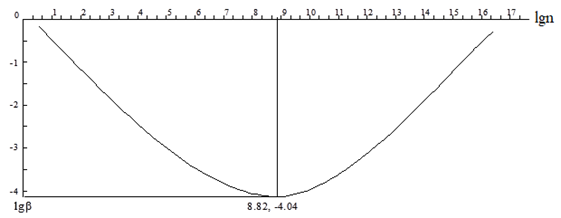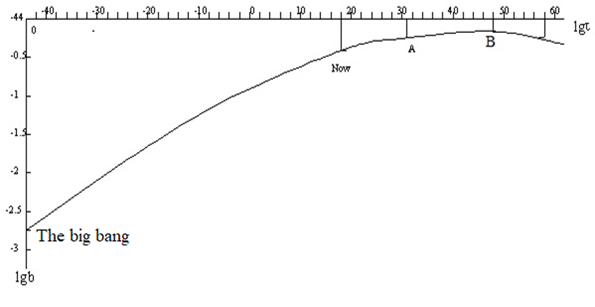
Research Article Volume 7 Issue 2
Space-time curvature and cosmic evolution
Shuming Li,1 
Regret for the inconvenience: we are taking measures to prevent fraudulent form submissions by extractors and page crawlers. Please type the correct Captcha word to see email ID.

Lihua Li Huang,2  Shuwei Li,3 Shuyun Li4
Shuwei Li,3 Shuyun Li4
1 Kansas State Department of Education, 900 SW Jackson St Suite 351, USA
2303 Ray St., Pleasanton, USA
3Livermore, California 94550, USA
4Shijiazhuang, P.R. China
Correspondence: Shuming Li, Kansas State Department of Education, 900 SW Jackson St Suite 351, Topeka, KS 66612, USA, Tel 9132698143
Received: May 18, 2023 | Published: May 25, 2023
Citation: Shuming L, Lihua LH, Shuwei L, et al. Space-time curvature and cosmic evolution. Phys Astron Int J. 2023;7(2):137-139. DOI: 10.15406/paij.2023.07.00298
Download PDF
Abstract
In the earlier article, the smallest physical constant was introduced and some new parameters were obtained to describe the elementary particles.1 Based on these new parameters, we have further derived several equations to calculate a particle’s accelerations, the space curvature radius, and the force that space-time exerts to a particle. The minimum and maximum mass of a possibly existing particle can also be calculated. It is quite intriguing that these results can even be used to describe the cosmic evolution with time.
Keywords: parameters, space time, curvature, accelerations, cosmic evolution
Introduction
Through many years of research, a new quantum constant ko = 9.4868845×10-60 erg×cm×s was discovered and introduced in the earlier article.1 It is the smallest value of the product of space interval, time interval, and energy for all physical system. We call this the Space-Time Quantum of Action (STQA).
Because ko is a very small constant, we can reasonably assume that the product of the space interval x, time interval τ, and energy E of all physical systems should be an integer multiple of ko. This is the STQA Hypothesis. Its formula is
then we can obtain the equation
and a + b + d = 1, where n is positive integer. k0=E0x0τ0 we can then we calculated the value of a, b, d, and n for every elementary particle and the whole universe. We have demonstrated that 1/a, 1/b, and 1/d are the fractal dimension of energy, space, and time of a particle or a physical system.1 Now we use the values of a, b, d, and n obtained in the earlier article to perform the following calculations.
A diagram of parameters of particles
According to the table I in our article,1 Fundamental parameters of particles based on the STQA hypothesis, every particle has a, b, d, and n values. If the abscissa stands for the logarithm of n, the ordinate stands for the values of a, b, and d of particles respectively, then a diagram can be drawn as Figure 1.

Figure 1 The relation between lgn and a, b, or d of particles.
According to this diagram, these equations can be found as follows:
For heavy particles, we have the equation (1):
(1)
For leptons we have the equation (2):
(2)
The range of the mass of particles
Based on equation (1), The inherent speed of heavy particles can be calculated using equation as shown in equation (3):
(3)
The equation (3) indicated that there is a minimum value of the inherent speed that corresponding a particular particle’s state, it is shown in Figure 2.

Figure 2 There is a minimum value of lgβ.
The minimum value can be calculated as shown in equation (4):
(4)
That is the bmin=9´10-5, this value corresponds to a particle that its mass is 2.4´105GeV/c2.
Obviously, this could be the heaviest particle. Since this particle’s inherent speed is at a minimum, similar to the quarks (the quarks’ inherent speed is very little according to the table 1), so it is very difficult to detect the heaviest particle by experiment so far.
For the leptons, we can use equation (2) to get the particle that its inherent speed is maximum value, and its mass is lightest in all particles as shown as shown in equation (5):
(5)
The experiment suggests that neutrino have a mass of 0.1eV/c2,2 which is greater than the mass of the lightest particle.
On the other hand, if we let a, b, and d can be represented by equations as shown in equation. (6) for all particles:
(6)
Whereare constants related to particles. We can deduce the equations that represent the inherent acceleration q, the inherent curvature radius of particles’ inherent motion r, and the inherent force that the space-time exerts to the particles F, as shown in equation (7), equation (8), and equation (9):
(7)
(8)
(9)
Where
We can calculate the values of q,, and F of all kinds of particles using the three equations. For example, for electron we have the equation (10):
(10)
For proton we have the equation (11):
(11)
For the heaviest particle we can get the equation (12):
(12)
According to above calculations, the lighter particles correspond to larger curvature radius and smaller force between particles and space-time. Thus, it is relatively easier to detect the particle that its mass between the heaviest and the lightest. In principle, we can calculate the inherent parameters of the motion of any system, such as atoms, molecules, the moon, the earth, the Galaxy, even the whole universe, as long as we known their values of n, . Therefore, the parameters of the motion and space-time of every particle or physical systems depend on the inherent nature of them.
The cosmic evolution
According to the equation (1) and equation (2), we can find that the formula to calculate the value of b are the same in both equations. This implies the relation between the value of b and the value lg n has nothing to do with the type of particles. Furthermore, we can think that formula to calculate the value of b fit to every physical system. We can get the equation (13):
(13)
According to equation (13), the maximum of the space size x can be calculated by equation (14):
(14)
Let’s recall the n value of our current universe it is 8.06324×10181 that is almost the same as the n value in equation (14). This means that the physical parameters of so small particles are closely related with the physical parameters of whole universe if this is not just a coincidence. For whole universe, its value of n we take 1.585´10183, and the value of n of whole universe should be a constant, let N = 1.585´10183. Therefore, based on the relationship between x and lg n, the maxima value of b can be obtained, it is 0.5494, and it is possible that there is a maximum size xmax = 1.28´1068cm, and a maximum age tmax = 4.23´1057 s for our universe.
Now let’s consider the start point of the universe, the big bang. The whole universe with total N = 1.585´10183 STQAs, into the extreme small space time rang. There is a minimum size x0 = 2.86´10-33 cm, and a minimum time t0 = 9.54´10-44 s. let x = 2x0, τ = 2τ0, based on the STQA hypothesis, we have
(15)
We can obtain:
a = 0.99661527, b = 1/607.9, d = 1/607.9, E = 10200 erg (16)
At this minimum value state, the value of b of whole universe is b = 1/607.9, this is the begin state of the big bang.
Now, we have three group of values of b and τ, they are given by the current value b = 0.33347, t = 4.3512×1017 s, b and t in the equation (14), and b and t in the state of the big bang respectively. According to the three group values of b and t, we can draw a quadric curve that represents the relation between lg b and lg t as shown in Figure 3.

Figure 3 The time evolution of the universe.
The equation of the curve in Figure 3 can be shown in equation (17):
(17)
The maximum value of b or lg b can be calculated using equation (18):
(18)
Based on Figure 3 and equation (18), we can see that the value of τ is about 1047s, which corresponds to the maximum value of lg b. Therefore, the maximum age of the whole universe would be 1047 s, which corresponds to a maxima size x max = 3´1057 cm. Currently, our universe’s size is x = 4.4×1028 cm, the age is t = 4.3512×1017 s. Thus, our universe is expected to be expanding continuously.
If the final speed of the universe expansion reaches the limit, the speed of light, we expect that the speed of the universe expansion is getting faster and faster3 from the b < 1 to the ultimate b = 1 with its age greater and greater, it agrees with the results of observation. Generally, every particle in the universe is accelerated from the speed of zero to the speed of light during 1047s, therefore, the average acceleration of the universe expansion can be calculated to be about 10-37cm/s2, which waits for examination by the observation.
According to the Figure 3, the value of b is increasing, or the space dimension Db of whole universe is decreasing gradually with the passage of time. Currently, the space dimension of universe is three, and it expects to decrease to two at the age of 1031 second, which corresponds to the point A on the curve. Then it can decrease to 1.86 at the age of 1047 second, which corresponds to the point B on the curve. The quadratic curve takes point B as the symmetric point, and the left and right are symmetrical, and repeats the opposite evolution process after point B.
Since these parameters can be calculated using the STQA theory, this pattern of evolution of the whole universe has nothing to do with the cosmological constant and the mass density of the universe. Thus, the STQA theory suggests a novel concept and method to resolve the important problem related to the structure of the matter and the evolution of the universe. It has been quite difficult to resolve these problems using existing physical theory as we know.
According to the equation (17), the value of b of the whole universe is changing slowly with the passage of time. The reciprocal of b is the fractal dimension of space, thus, the fractal dimension of the space of the universe is decreasing gradually. Because the nature of self-similar of the fractal set, then the void / hole of space-time in every size scale will be created with the space dimension of the universe become less than three gradually. Based on the STQA theory, it could possibly produce an important influence on the living being that we have never been imagined before.
Conclusion
Based on the STQA theory, we can calculate the mass of the lightest and heaviest of particles, which are 1.37´10-5 eV/c2 and 2.4´105 GeV/c2, respectively. The particle’s accelerations, the space curvature radius, and the force that curved space-time exert to a particle can be calculated. Those results are waiting for the validation of experiments.
The STQA theory suggests a novel concept and method to resolve the important problem related to the structure of matter and the evolution of universe. The dimension of the universe is changing as the time goes on, and its range of variation is from 607.9 to 1.86 with the current dimension at 3. The maximum size for the universe expansion is 1057 cm, and it corresponds to the age of the universe of 1047 second. At the same time, the average acceleration of the universe expansion can be calculated as 10-37cm/s2, which could be validated by experimental observation in the near future. Thus, the STQA theory might lead to significant scientific advancement.
Acknowledgments
Conflicts of interest
References

©2023 Shuming, et al. This is an open access article distributed under the terms of the,
which
permits unrestricted use, distribution, and build upon your work non-commercially.


